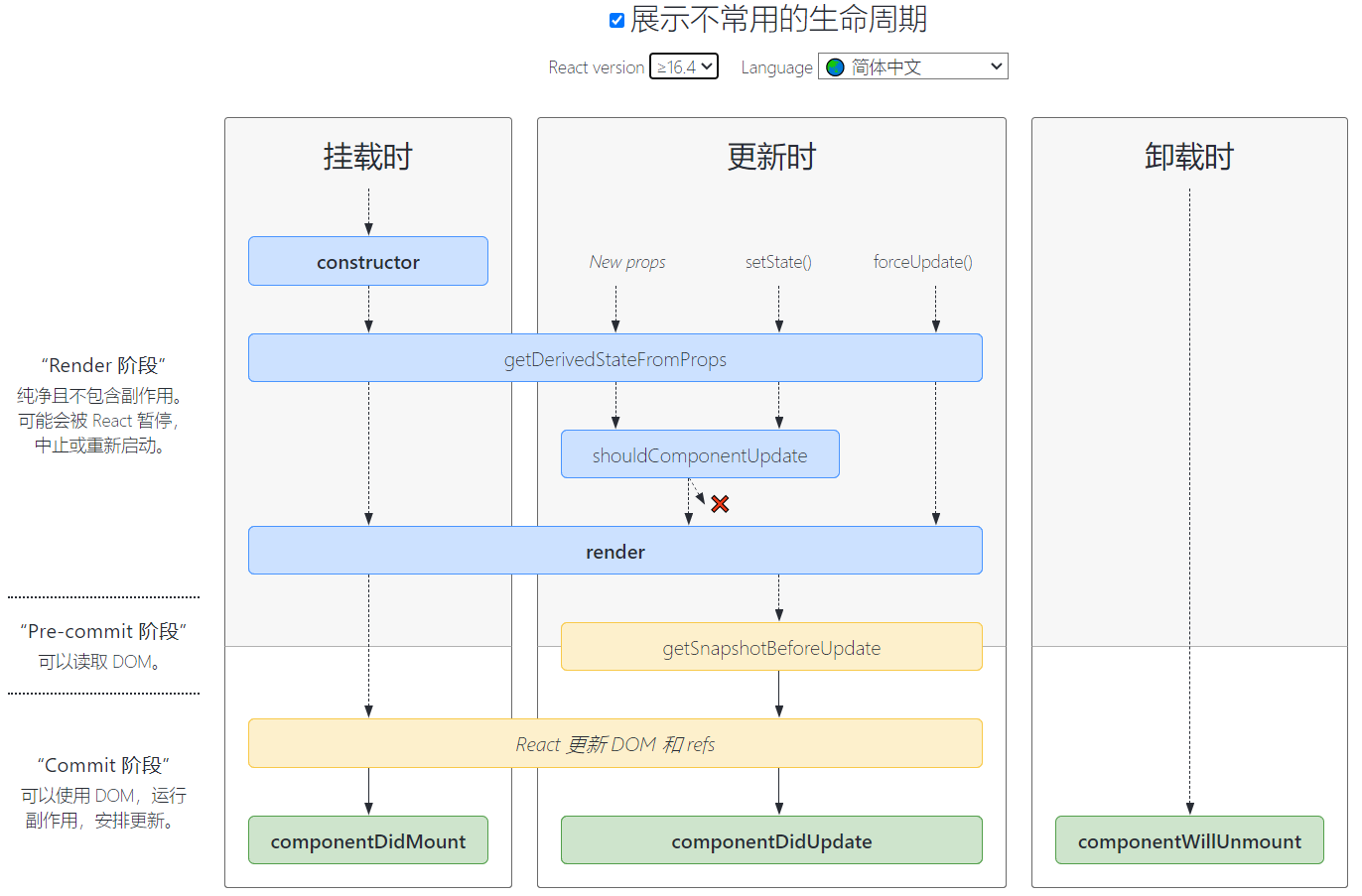React类组件生命周期及使用场景

生命周期方法
constructor(props) 🔗
- 用于初始化内部状态,很少使用。
- 唯一可以直接修改
state的地方。
getDerivedStateFromProps(不推荐使用) 🔗
- 当
state需要从props初始化时使用。 - 尽量不要使用:维护两者状态一致性会增加复杂度。
- 每次render都会调用。
- 典型场景: 表单控件获取默认值。
componentDidMount 🔗
- UI渲染完成后调用。
- 只执行一次。
- 典型场景: 获取外部资源(AJAX请求)。
componentWillUnmount 🔗
- 组件移除时被调用。
- 典型场景:资源释放。
shouldComponentUpdate(nextProps, nextState, nextContext) 🔗
- 决定Virtual DOM是否要重绘。
- 一般可以由 PureComponent (类似
Component, 但当props和state与之前一致时会跳过重新渲染)自动实现。 - 典型场景:性能优化。
getSnapshotBeforeUpdate(prevProps, prevState) 🔗
- 在页面
render之前调用,state已更新。 - 典型场景:获取
render之前的DOM状态。
componentDidUpdate(prevProps, prevState, snapshot?) 🔗
- 每次UI更新时被调用。
- 典型场景:页面需要根据
props变化重新获取数据(例如文章详情页切换文章,内容根据ID来变化)
componentDidCatch(error, info) 🔗
- 捕获渲染过程中发生的错误。
- 典型场景:错误边界。
getDerivedStateFromError(error) 🔗
捕获子组件抛出的错误,更新
state以显示降级 UI。是一个纯函数,若想执行副作用你想执行副作用(例如调用分析服务),你还需要实现
componentDidCatch。典型场景:错误边界
生命周期方法执行顺序
一、挂载阶段(Mounting)
组件被创建并插入DOM的阶段,执行顺序如下:
constructor: 初始化state或绑定事件。避免在构造函数中执行副操作(如请求数据)。getDerivedStateFromProps: 根据props更新state。render: 必须实现的方法,返回 JSX 或null,需保持纯函数特性。componentDidMount: 组件挂载到 DOM 后调用,适合执行副作用操作(如 API 请求、DOM 操作、订阅事件)
二、更新阶段(Updating)
组件因 props 或 state 变化而重新渲染的阶段,执行顺序如下:
getDerivedStateFromProps: 同挂载阶段,在每次更新前调用,根据props更新state。shouldComponentUpdate: 判断是否需要重新渲染。render: 重新渲染组件。getSnapshotBeforeUpdate: 在 DOM 更新前捕获信息(如滚动位置),返回值需要传给componentDidUpdate的第三个参数,必须和componentDidUpdate配合使用。componentDidUpdate: 组件更新后调用。
三、卸载阶段(Unmounting)
组件从 DOM 中移除的阶段:
componentWillUnmount: 组件从 DOM 中移除前调用,适合执行清理操作(如取消订阅、清除定时器)。
四、错误处理(Error Handling)
组件渲染过程中发生错误时触发:
getDerivedStateFromError: 捕获子组件抛出的错误,更新state以显示降级 UI。componentDidCatch: 捕获渲染过程中发生的错误。
两个例子
jsx
import React from 'react'
export default class Clock extends React.Component{
constructor(props) {
super(props);
console.log("Clock constructed")
this.state = { date: new Date()}
}
componentDidMount() {
console.log('Clock did umount')
this.timeID = setInterval(()=>this.tick(),1000)
}
componentWillUnmount() {
console.log("Clock will unmount")
clearInterval(this.timeID)
}
componentDidUpdate() {
console.log('Clock did Update')
}
tick(){
this.setState({
date:new Date()
})
}
render() {
return (
<>
<h2>
It is {this.state.date.toLocaleTimeString()}
</h2>
</>
)
}
}jsx
import React, { PureComponent } from "react";
export default class SnapshotSample extends PureComponent {
state = {
messages: [],
};
handleNewMessage() {
this.setState(prev => ({
messages: [`msg ${prev.messages.length}`, ...prev.messages],
}));
}
componentDidMount() {
for (let i = 0; i < 20; i++) this.handleNewMessage();
this.interval = window.setInterval(() => {
if (this.state.messages.length > 200) {
window.clearInterval(this.interval);
return;
}
this.handleNewMessage();
}, 1000);
}
componentWillUnmount() {
window.clearInterval(this.interval);
}
getSnapshotBeforeUpdate() {
return this.rootNode.scrollHeight;
}
componentDidUpdate(prevProps, prevState, prevScrollHeight) {
const scrollTop = this.rootNode.scrollTop;
if (scrollTop < 5) return;
this.rootNode.scrollTop =
scrollTop + (this.rootNode.scrollHeight - prevScrollHeight);
}
render() {
return (
<div className="snapshot-sample" ref={n => (this.rootNode = n)}>
{this.state.messages.map(msg => (
<div>{msg}</div>
))}
</div>
);
}
}总结
总得来说:
- 挂载时调用
constructor,更新时不调用。 - 更新时调用
shouldComponentUpdate和getSnapshotBeforeUpdate,挂载时不调用。 shouldComponentUpdate在render前调用,getSnapshotBeforeUpdate在render后调用。- 请求放在
componentDidMount里。
原因是 constructor 无法放AJAX请求,是因为它会在SSR的时候会被调用,是会在服务端进行调用,服务端是拿不到数据的,更新时的钩子放请求会不断调用,可能会造成死循环,卸载时的钩子只会在生命周期结束的时候进行调用。